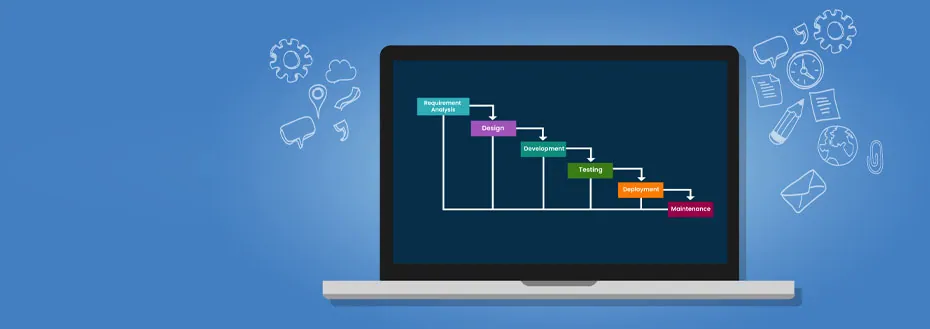SDLC is the most important framework for organizing software development as a process that promotes organizational growth in an era of technology-driven industry growth and innovation. SDLC has evolved to deliver software development that is now structured, align technical initiatives with strategic objectives, minimize risks, and use resources efficiently. This article examines each phase of the SDLC, and how organizations can align it with business goals, emphasizes risk management strategies, and underscores the importance of continuous improvement to sustain success.
Why SDLC Matters for Enterprises?
SDLC for an organization is more than a technical process; it is a strategic implementation of solutions that align with business objectives. System development life cycle methodology ensures that software solutions are robust, scalable, and adaptable to changing market dynamics.
Understanding the types of system development life cycle approaches can help break down complex development efforts into manageable stages—the key to project planning and reducing risk—while improving organizations' transparency, collaboration, and efficiency. Effective software development life cycle management drives quality software; it increases productivity, reduces costs, and therefore becomes an asset in competitive markets.
Stages of the System Development Life Cycle Models
-
Planning and Requirement Analysis
This is the initial stage for the entire project as it sets specific, actionable goals that meet business priorities. Requirements analysis involves in-depth consultation sessions with relevant key stakeholders, including executives, end users, and project managers, to gain a detailed understanding of what the software needs to achieve, potential risks, and key success metrics.
The output is a requirement specification document that acts as a roadmap, eliminating uncertainty and averting subsequent, expensive scope modifications.
-
System Design
The design phase translates the business and operational requirements into a concrete system architecture. This ranges from high-level designs such as data flow diagrams, entity-relationship models, and user interface layouts to more detailed component-level designs. Security, scalability, and system integration are among the items that are seriously considered here.
Organizations benefit from validation sessions, where proposed solutions are examined against real-world scenarios to ensure that they meet the current and future demands of businesses.
-
Development
Development—often referred to as the "build" phase—involves creating software based on a design specification, with a tight emphasis on coding standards, modular programming, and thorough documentation.
Development teams collaborate with business stakeholders so that it is aligned with business goals and responds quickly to evolving needs. Automated tools for code validation and continuous integration/testing support efficiency, allowing for faster delivery of functional builds to test and review.
-
Testing
Testing is the only way to demonstrate how software should perform and meet quality specifications. There are different types of testing, including unit testing, integration testing, system testing, and user acceptance testing, which test functionality, performance, and security.
Enterprise solutions look for defects early on, so they don't roll back later. Test automation, performance benchmarking, and load testing all help provide some real-world usage scenarios to make the software more reliable and robust under various conditions.
-
Deployment
The transition from a development and test environment to a live production environment for system deployment should be planned to minimize operational disruptions. Based on risk assessment and business requirements, deployment options such as direct cutovers, parallel implementation, and phased rollouts are selected.
Effective deployment requires user training, system monitoring, and support readiness to ensure smooth adoption of the change by users. Feedback mechanisms allow organizations to quickly resolve post-deployment issues to increase user satisfaction and operational consistency.
-
Maintenance and Updates
Maintenance is an ongoing phase of refining a system to comply with ever-changing business requirements, eliminate bugs, and improve performance. Proactive monitoring, patch management and feature enhancements ensure that software is secure, compatible, and operationally efficient.
Data analytics and performance metrics are tools used by enterprises to measure system health and user engagement levels to make informed decisions about future updates and optimization. This position reinforces long-term operational resilience and increases the value of technology investments.
Aligning SDLC with Business Goals
For organizations involved, aligning SDLCs with business objectives means more than just software development. It's about measurable results that make a strategic difference. Incorporating software development services into this alignment ensures that technical solutions are expertly crafted to meet each unique business need.
A proper alignment between IT and business requires mutual collaboration and translating more conceptual organizational goals into actual features and functionality for software. In this manner, business value can be considered at each stage of the SDLC, leading to improved customer experiences, operational streamlining, and opening revenue streams.
Some other examples of process alignment include customer feedback loops, automation of business-critical processes, and facilitation of digital transformation initiatives.
Aligning SDLC with Business Goals
For organizations involved, aligning SDLCs with business objectives means more than just software development. It's about measurable results that make a strategic difference. Incorporating software development services into this alignment ensures that technical solutions are expertly crafted to meet each unique business need.
A proper alignment between IT and business requires mutual collaboration and translating more conceptual organizational goals into actual features and functionality for software. In this manner, business value can be considered at each stage of the SDLC, leading to improved customer experiences, operational streamlining, and opening revenue streams.
Some other examples of process alignment include customer feedback loops, automation of business-critical processes, and facilitation of digital transformation initiatives.
Selecting the Best SDLC Model for Your Business
Choosing SDLC models is important because it defines flexibility, speed, or how the system development process should be structured. Considering the advantages of system development life cycle models can enhance decision-making by ensuring the chosen approach aligns with project needs.
Traditional waterfall models have a structured linearity to projects and their requirements are precisely defined, while Agile emphasizes flexibility, collaboration, and iterative approaches to development. Hybrid models can help companies blend both approaches to their best advantage.
Project complexity, team size, risk tolerance, and time-to-market constraints are some of the important factors that guide the model selection process. In such a rapidly changing environment, adopting an Agile or DevOps approach can unleash innovation and accelerate delivery cycles, allowing companies to quickly seize market opportunities.
Managing Risk and Ensuring Compliance in SDLC
Risk management and regulatory compliance are among the most important aspects of an effective SDLC. Organizations must integrate security and compliance requirements into the development cycle to eliminate threats and comply with industry standards.
Safety audits are scheduled periodically. Data protection mechanisms are in place to protect information and ensure compliance with respective rules and regulations such as GDPR and HIPAA.
Also, risk management frameworks identify, analyze, and mitigate potential threats at each stage of the SDLC, which minimizes vulnerabilities in a system and keeps the business running.
Conclusion
An effective SDLC, aligned with an organization's goals and supported by continuous improvement, is a solid foundation for creating sustainable and scalable solutions with high quality in software development. On the other hand, an organization can increase its operational agility and generate growth through the use of data-driven insights with the help of integrated risk management features.
Contact our experts to find solutions designed and tailored to your approach towards an SDLC strategy aligned with your business goals for an organization's success.
Contact UsAvail best-in-class services at affordable rates
Our Customers





Software Development Case Studies
-
Flatworld Implemented a ServiceNow Solution for a US-based Award Winning Firm
-
FWS Provided Swift and Impeccable ServiceNow Implementation Services
-
Flatworld Provided Power BI Services to a UK-based Data Analytics Firm
-
Developed an e-Learning Platform for a Global IT Organization
-
Bilingual OpenCart e-commerce Solution for Canadian Boat Manufacturer
3rd Edition Middle East Banking AI and Analytics Summit

USA
Flatworld Solutions
116 Village Blvd, Suite 200, Princeton, NJ 08540
PHILIPPINES
Aeon Towers, J.P. Laurel Avenue, Bajada, Davao 8000
KSS Building, Buhangin Road Cor Olive Street, Davao City 8000
INDIA
Survey No.11, 3rd Floor, Indraprastha, Gubbi Cross, 81,
Hennur Bagalur Main Rd, Kuvempu Layout, Kothanur, Bengaluru, Karnataka 560077






